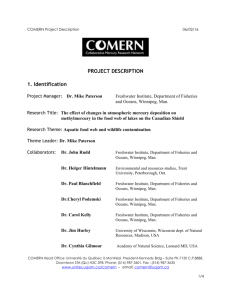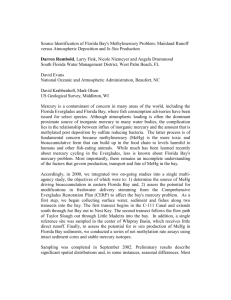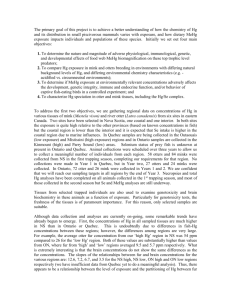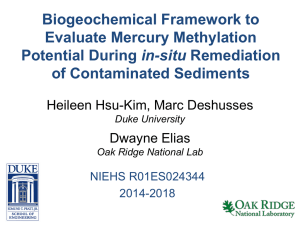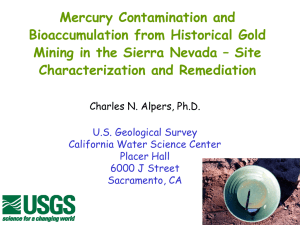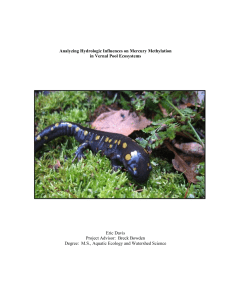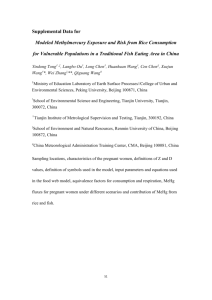0_Olsen_Todd
advertisement
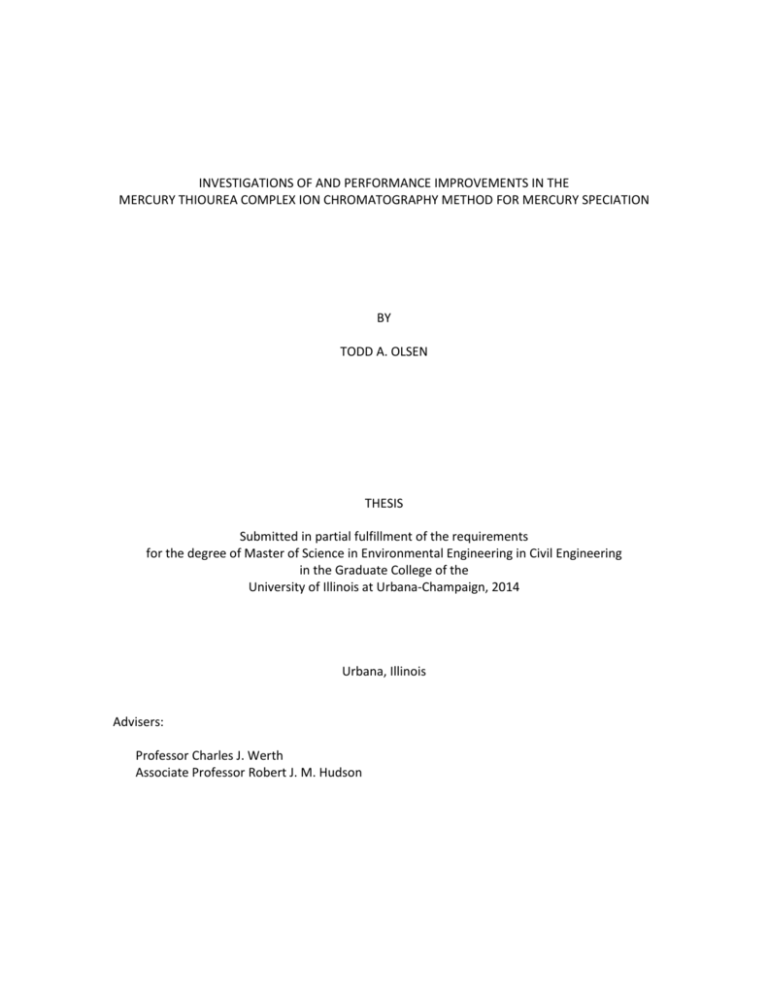
INVESTIGATIONS OF AND PERFORMANCE IMPROVEMENTS IN THE MERCURY THIOUREA COMPLEX ION CHROMATOGRAPHY METHOD FOR MERCURY SPECIATION BY TODD A. OLSEN THESIS Submitted in partial fulfillment of the requirements for the degree of Master of Science in Environmental Engineering in Civil Engineering in the Graduate College of the University of Illinois at Urbana-Champaign, 2014 Urbana, Illinois Advisers: Professor Charles J. Werth Associate Professor Robert J. M. Hudson ABSTRACT The Hg thiourea (TU) complex ion chromatography (HgTU-IC) method for mercury speciation analysis, first developed at UIUC, was the subject of an in depth investigation aimed at i) understanding the causes of system performance problems, ii) optimizing its chemistry, and iii) coupling it to ICP-MS detection. The new system chemistry described herein is capable of reliably, accurately, and sensitively quantifying both monomethyl (MeHg) and mercuric (HgII ) mercury species, and unexpectedly demonstrates the presence in freshwater samples of previously unknown Hg species with low net charge that are chemically different from both MeHg and HgII. In addition, it is shown that the system’s preconcentrator effectively traps both MeHg and HgII in samples containing strong Hg-binding ligands − 1 mM glutathione, thiosalicylic acid, and 0.15 M thiourea – giving it capabilities for rapid analysis of samples containing such ligands that the standard methods for low-level Hg speciation do not have. Although previous HgTU-IC system chemistries had high sensitivity and effectively separated MeHg from HgII, there were three problems that became apparent with their use over an extended period of time. The first was random, narrow spikes in the signal caused by particle formation in the post-column reaction coils. This issue was solved here by optimizing the oxidation chemistry and replacing SnII with BH4- as the reducing agent. A second arose when the manufacturer ceased production of the base gel used in synthesis of resin for the system’s preconcentrator. A replacement product, a commerciallyavailable thiol resin, was shown to effectively trap MeHg and HgII in samples of at least 5-mL volume even when the matrix includes components known to interfere with MeHg analysis, i.e., thiol compounds. However, the strongest commonly-occurring ligand, hydrogen sulfide, did inhibit trapping of HgII at 1 mM. The third and arguably most important problem was identified and corrected while investigating the cause of inter-method differences in MeHg measured in samples from freshwater systems. Analyzing such samples using the original separation chemistry along with ICP-MS detection and ii isotopically-labeled internal standards revealed that the ambient Hg in the “MeHg” peak had a distinctly different shape from the internal standard. As the ion chromatographic separation is dependent on the [H+] in the mobile phase, it was shown that the misshapen peak could be resolved into true MeHg and one or more previously unknown inert Hg species that are at least partially trapped by the preconcentrator. Results obtained with this chemistry agree with distillation/ethylation-GC, but for some freshwater samples, results obtained using the previous HgTU-IC chemistries were biased high because they combined this inert Hg species with MeHg. Other tests with isotopic tracers showed that the TU-catalyzed SPE and HgTU-IC do not create a MeHg artifact from HgII during sample preparation or analysis and that with the addition of a longer IC column, the system is capable of measuring MeHg and EtHg in a single sample preparation/analysis. Using a slightly different mobile phase composition, the method can quantitate HgII directly. Method detection limit (MDL) studies were performed for MeHg and HgII resulting in a MeHg MDL of 0.003 ng/L and a HgII MDL of 0.01 ng/L for 40 mL samples. The MeHg MDL rivals that of ethylation/GC and exceeds those of other HPLC methods. The HgII MDL rivals the best HPLC methods in use. iii ACKNOWLEDGMENTS I would especially like to thank Dr. Robert Hudson for bring me onto this project and for his committed guidance during all phases of the research as well as help in preparing my thesis. All the work done on this project was in Dr. Robert Hudson’s lab in NRES department. I would also like to thank Dr. Charles Werth for his support during my transition into the Environmental Engineering Department. I would like to extend my thanks to Richard Ryu for his contribution to the method development during the early stages of this project. Last but not least I would like to thank my parents and family for their love and support. Financial support for this work came from the Natural Resources Conservation Service via the Iowa Soybean Association and from the Electric Power Research Institute. iv TABLE OF CONTENTS CHAPTER 1: INTRODUCTION…………………………………………………….………….………………………………………………….1 CHAPTER 2: MATERIALS AND METHODS……………………………………….……………………………….………………………..5 CHAPTER 3: HGTU-IC POST COLUMN SYSTEM CHEMISTRY…………………………………………………………………….11 CHAPTER 4: HG PRECONCENTRATION AND CHROMATOGRAPHIC SEPARATION………..….……….………………14 CHAPTER 5: NATURAL WATER ANALYSIS USING ICP-MS DETECTION……………………………………………………..18 CHAPTER 6: CONCLUSIONS ……………………………………………………………………………………………………………………22 CHAPTER 7: FIGURES AND TABLES…………………………………………………………………………………………………………23 REFERENCES…………………………………………………….……………………………………………………………………………………30 v CHAPTER 1 INTRODUCTION In studies of Hg biogeochemistry and transport in freshwater ecosystems, the speciation of mercury (Hg) is rarely if ever completely quantified. Rather, chemists typically analyze total (THg) and monomethyl Hg (MeHg) and, in a few studies, dissolved Hg0. While the latter two forms of Hg are important, they usually comprise a minor fraction of the total. The balance of the total is generally presumed to be mostly mercuric Hg, although HgII is not directly measured nor are the potential contributions of other species examined.1 Evidence has been building that there are strong inert HgII complexes in environmental samples that, using typical Hg speciation protocols, would be measured as dissolved HgII.2 Having a method to separate dissolved HgII from inert HgII may become important in determining the fate and speciation of Hg in the environment. Ideally, a complete speciation scheme for water samples would combine timely stripping of Hg0 with a method that is capable of preconcentrating all non-volatile Hg species and then separating and quantifying them individually. The standard method for MeHg analysis is by ethylation/gas chromatography (GC) where MeHg is converted to methyl ethyl mercury and separated from other forms of Hg via GC.3 Ethylation/GC is an absolutely essential tool, but in a single sample preparation this method cannot separate all forms of Hg. Distillation is required to separate MeHg from matrix species to ensure complete ethylation, but HgII is left behind in the residue along with a portion of the MeHg.4 Also in some cases distillation has been shown to create a MeHg artifact.5 This makes finding alternative methods for MeHg analysis important both to validate current methods and to enable different sample preparation techniques. Most HPLC approaches use reverse phase chromatography and are able to measure many Hg species in one sample prep including MeHg and HgII.6,7 However, these methods suffer from high detection limits and limited sample volume capacity. There have also been methods published using ion 1 chromatography for the speciation of MeHg from HgII that warrant further investigation because of the possibility of large sample volumes and low detection limits, particularly Hg thiourea (TU) complex ion chromatography (HgTU-IC).8–12 The basis of the HgTU-IC system (Figure 1) is the separation of Hg species using an aqueous mobile phase (eluent) in which the coordination states of MeHg and HgII are both well-defined and independent of the original sample matrix. The chosen mobile phase is an aqueous solution of hydrochloric acid (1 M), TU (0.15 M) and acetic acid (1.75 M), which yields conditions where most strong Hg-binding ligands, including thiols and bisulfide, are readily displaced and aqueous speciation is dominated by MeHgTU+ and Hg(TU)42+.8,9 𝐻𝑔𝑇𝑈42+ + 𝑅 − 𝑆𝐻 ↔ 𝑅 − 𝑆 − 𝐻𝑔𝑇𝑈𝑛+ + (4 − 𝑛)𝑇𝑈 + 𝐻 + 𝐶𝐻3 𝐻𝑔𝑇𝑈 + + 𝑅 − 𝑆𝐻 ↔ 𝑅 − 𝑆 − 𝐻𝑔𝐶𝐻3 + 𝑇𝑈 + 𝐻 + Equation 1 Equation 2 A second important reason for including TU in the mobile phase is that it facilitates the loading and unloading of analytes onto and from a preconcentrator containing a thiol resin (Figure 1, step 2, TT), which can preconcentrate Hg species from reasonably large volume samples even when they contain ligands that strongly bind Hg. The tendency of Hg species to adsorb can be manipulated simply by adjusting the pH of the aqueous, thiourea-containing solution pumped through it.13,14 Analytes are trapped during a near-neutral pH loading step and eluted into the mobile phase at pH < 1 (Equations 1 and 2). After desorption, the eluent stream carries the analytes through a standard ion chromatography column (ICC) (Figure 1, step 3) where transport of the Hg(TU)42+ complex is retarded more than the MeHgTU+ complex due the stronger tendency of the doubly-charged complex to adsorb to the sulfonate resin: X SO4 H MeHgTU X SO4 MeHgTU H 2 X SO4 H Hg (TU ) 42 X SO4 2 2 Hg (TU ) 42 2 H Equation 3 Equation 4 This adsorption of the Hg complexes onto the resin should be pH-dependent, since H+ is the main cation in the mobile phase. By optimizing the pH of the eluent, complete (baseline) separation between the leading MeHg and trailing HgII peaks can be achieved.8 To obtain high sensitivity detection, the separated Hg species are transferred from the mobile phase to a carrier gas stream using a multi-step online reaction process. First, the difficult-to-reduce MeHg species is oxidized to HgII by a post-column oxidation reaction (Figure 1, step 4): 40 C MeHg Ox Hg II Equation 5 The same oxidation step also breaks down the TU, which would otherwise inhibit HgII reduction. After quenching excess oxidant (Figure 1, step 5) and neutralizing the acid (Figure 1, step 6), the HgII is reduced to Hg0 under alkaline conditions (Figure 1, step 7) before the sample stream is fed into a gas liquid separator, where Hg0 is stripped into the gas phase (Figure 1, step 8) and the cold vapor carried to the detector (Figure 1, step 9): 0 𝐻𝑔II → 𝐻𝑔(𝑎𝑞) → 𝑅𝑒𝑑𝑢𝑐𝑡𝑖𝑜𝑛 𝐺𝐿𝑆 𝑙𝑜𝑜𝑝 0 𝐻𝑔(𝑔) Equation 6 The HgTU-IC system is compatible with detection by atomic fluorescence after drying the carrier gas stream or by ICP-MS as shown here.8 The goal of this work was to investigate the chemistry and improve the performance of the recently-developed HgTU-IC speciation/reaction system and explore its use with ICP-MS detection.8–10 Herein, we report a new system chemistry that increases the system’s sensitivity and eliminates perturbations in the baseline that sometimes occurred. When the revised post-column chemistry was applied to analyzing natural water samples spiked with isotopically-labelled tracers, it became apparent that species other than MeHg and HgII are often present and can co-elute with MeHg with the original eluent chemistry. While the original eluent is nearly ideal for quantifying HgII, we found that it is necessary to use a less acidic mobile phase in order to separate MeHg from the other unidentified peaks 3 and from ethylmercury (EtHg). Under these conditions, MeHg can be accurately quantified with high sensitivity. 4 CHAPTER 2 MATERIALS AND METHODS 2.1 System Equipment and Materials Although the HgTU-IC analytical system used here (Figure 1) resembles previously-published versions in most respects,10 the system equipment and its operation have been thoroughly re-examined and both evolutionary and radical changes introduced. From beginning to end, the current system employs the following equipment and materials: isocratic HPLC pump with all-PEEK flow path (Chromtech Model III), peristaltic pump for loading samples (Gilson Minipuls 3), 10-port sample injection valve with CheminertTM flow path (Gilson Valvemate® II) with a) preconcentrator (1.6×31-mm PEEK tube, IDEX Health & Science, Oak Harbor, WA) filled with thiol-functionalized silica gel (Silicycle SiliaMetS®-Thiol, 40-63 m, Montreal) and sample loop, one or two Dionex CG-5A (4×50 mm) mixedbed ion chromatography guard column(s), Masterflex digitally-controlled peristaltic pump with 8-roller head for post-column injection of reagents, reaction coils made of 1/16”-OD PFA tubing and joined with PEEK Y-connectors, mass flow controller (0-300 SCCM Ar, Pneucleus Technologies, Hollis, NH), borosilicate glass gas-liquid separator (GLS) (7.5-cm long internal finger-type, Allen Glass, Boulder, CO), Masterflex digitally-controlled peristaltic pump for post-GLS waste removal, and Agilent 7500S inductively coupled plasma mass spectrometer (ICP-MS). Note that with the addition of a Nafion drying tube on the post-GLS Ar stream, the same equipment will function with AFS detection. Samples loaded onto the thiol trap are pumped through 1/16”-OD PFA and PEEK tubing with a 12cm section of Tygon (1.02-mm ID, Type 3603) in the pump head. All tubing along the main path of liquid flow is made of either PEEK (before the column) or PFA (after the column) and connected with PEEK fittings (TEFZEL low-pressure flanges). After each reagent is introduced into the main fluid stream, the mixtures flow through a reaction coil designed to allow sufficient time for mixing and/or reaction (Lengths: Oxidant, 6.3 m; Antioxidant, 3 m; Base, 0.07 m; Reductant, 2 m). The reagent pump employs 5 Pharmed and Tygon tubing in the pump head. All argon feed lines are made of PTFE tubing with stainless steel connectors. Argon sample flow is via PTFE tubing with Tygon slip-fit junctions to glass. The system is located in a lab directly fed with outside air that is conditioned and filtered twice through HEPA filters. Sample preparation and injection occur under laminar flow HEPA-filter units. 2.2 System Reagents Most system reagents (Table 1) were prepared fresh each day using reagent grade chemicals (Fisher Scientific or Sigma Aldrich) without further cleanup, except hydrochloric acid (Trace Metal grade, Fisher), potassium bromate (Fisher) baked at 500 C, argon (UHP grade), and TU (specially cleaned reagent grade, Alfa Aesar). Stock solutions were prepared by dissolving chemicals in 18 M-cm deionized water (DIW) pre-treated with a resin that removes DOM. Reagents were prepared and samples handled in clean areas under laminar-flow, HEPA filter units. Successful operation of the system absolutely requires use of low-Hg, unoxidized TU. Upon purchase, batches of TU must be examined for evidence of excessive breakdown (strong sulfur smell or yellow color) and stored in a freezer. As reagent grade TU can contain substantial amounts of Hg, TU stock solutions should be cleaned by batch equilibration with DOWEX 50WX8 100-200 mesh at 10-g per 76-g TU in 1 L DIW. As Cu catalytically oxidizes TU, the DOWEX should be acid-washed, neutralized with KOH/EDTA and rinsed with DIW before use with TU. Alternatively, TU solutions can be pumped through acid cleaned Silicycle Silia MetS-Thiol SPE cartridges (0.5-g). Clean TU stocks can be stored at 4 C for 14 days, or kept frozen, but we normally prepare eluent fresh each day. Oxidation of TU solutions can be detected by testing for the formation of white, S-containing particles after buffering to pH 4-5. All labware used for reagent preparation was made of PETG, PFA, or borosilicate glass. Prior to use, labware was cleaned by i) soaking in Micro detergent solution at 60 C for 12-h, ii) soaking in 4 M HCl for 48-h, and iii) rinsing with copious amounts of DIW iv) dried under laminar flow hood. 6 To avoid the formation of particles in the reduction loop observed when using the alkaline Sn employed in previous work,8–10 an acidic SnII reductant (20% SnII in 20% HCl at 1 mL/min)15 was tested and found to permit operation without Sn particles forming. This chemistry used the same eluent, oxidant and anti-oxidant as above, but no injection of base prior to the reduction step was necessary. For the same reaction time (reduction coil length) the acidic SnII method has a lower sensitivity than the BH4- method described later. 2.3 System Operation Preconcentrator and column: To ensure consistent performance of the injection system both the thiol trap and IC column should be cleaned of Hg before analysis. To clean the thiol preconcentrator 2050mL of 0.5 M TU/2 M HCl is pumped through the trap at a rate of 3 mL/min. A dirty preconcentrator can be identified by switching back and forth between the sample loop and the thiol preconcentrator and monitoring the baseline. If the preconcentrator is dirty there will be a positive shift in the baseline when the eluent is flowing through the trap compared to when it is flowing through the sample loop. To clean the IC column, pump 2 M HCl/0.1M TU through the column at 1 mL/min for 10-20 minutes then flush with the appropriate eluent for that days run. Reaction coil tubing flush: After each analytical run the reagent lines are flushed with DIW. The HPLC line and reaction loops are first flushed with 2 M HCl/0.1 M TU for 10 minutes at 0.5 mL/min then the IC column is removed before a final rinse with DIW for 10 minutes. This helps prevent buildup and clogging of reaction flow lines. Sample loading: There are two methods of injecting samples into the system: 1) The sample loop permits injection of small (10-1000 L) volumes of sample in a matrix similar to the mobile phase; 2) The preconcentrator retains the Hg from a 1-20 mL volume of sample which is then eluted into the ICC by the mobile phase. Prior to loading onto the preconcentrator, samples are buffered to pH 4-5 using 4 M KOH and/or 0.75 M sodium citrate. Sample loading proceeds by pumping the following sequence of 7 solutions through the preconcentrator at a rate of about 3 mL/min: i) 0.1-mL of eluent, ii) 0.75-mL of DIW, iii) 1 mL of 0.1 M sodium citrate, iv) the buffered sample, v) 1.0 mL of DIW, and vi) 0.75-mL of eluent. By switching the injection valve at appropriate times, the tubing can be kept clean and only 0.25 mL of sodium citrate, the sample, and most of the second DIW slug pumped through the preconcentrator itself. 2.4 Sample Preparation Solid phase extraction (SPE)/pre-concentration: To analyze low-level HgII and/or MeHg in natural water samples, an off-line SPE step is used to pre-concentrate the Hg and reduce the amounts of undesirable matrix components (DOM and other metals) injected into the online system. The offline SPE procedure is slightly modified from that developed by Vermillion and Hudson.9 Briefly, 100-mg of thiol-functionalized resin (SiliaMetS-Thiol, Silicycle) is slurry-packed in a borosilicate glass column (1×5cm), where it can be used to concentrate Hg from multiple samples. Before each sample is loaded, the resin is washed with ethanol, eluent (10 mL of 1 M HCl recipe), DIW (10 mL), and sodium citrate buffer (1 mL of 0.75 M). Then, a water sample 20 to 1000-mL in volume at pH 4-5 is pumped through the column. Finally, the adsorbed HgII and MeHg is eluted into 4 mL of eluent (1 M HCl recipe) and kept frozen until analysis. Note that relatively little of the dissolved organic matter from the original water sample ends up in the final eluate (prepared sample). Much of the DOM flows through the resin column without being adsorbed and most of the DOM that does adsorb is left on the resin when the Hg is eluted. This cleanup enables one to load samples online without plugging the preconcentrator and removes solutes that might affect the performance of the online thiol resin or IC column. Total mercury digestion: A sample oxidation step adapted from EPA Method 1631 is used for THg analysis.16 The sample is brought to 1-5% BrCl in order to oxidize DOM and allowed to react for 24 h. To quench excess BrCl, hydroxylamine solution (30%) is typically added at 15 L per 10-mL of sample. 8 Finally, the digested sample is brought up to 50 mM in clean TU to prevent adsorption of HgII to the sample vial and the sample introduction system while the sample is buffered to pH 4-5, i.e., from the start of the loading process until the HgII adsorbs to the online preconcentrator. Distillation: For distillation we heated 50 mL samples, with sulfuric acid and potassium bromide added, in PTFE vessels using a hot silicone oil bath at 125 C. Ultra high purity argon gas was bubbled through the sample and the distillate was collected in 50-mL PTFE receiving vessels with starting volume of 5 mL DIW.15 Isotopic Tracers: Isotopically-enriched MeHg and HgII tracers were generously provided by H. Hintelmann (Trent University). This included 198Hg-enriched MeHg, 199Hg-enriched MeHg, 202Hg-enriched MeHg, 198Hg-enriched HgII, 199Hg-enriched HgII, and 202Hg-enriched HgII. Hg Standards: The daily MeHg standard, prepared by dilution of primary standard (Brooks Rand) into eluent, was used to calibrate the system for MeHg, HgII, and THg analysis. 2.5 Samples Analyzed Synthetic Samples: Synthetic samples were made to mimic water from natural freshwater systems. Three sample types were prepared: “Low Hg/DOM” (0.2 ng/L MeHg, 1 ng/L HgII, 2 mg/L DOM); “Mid Hg/DOM” (0.8 ng/L MeHg, 4 ng/L HgII, 8 mg/L DOM), and “High Hg/DOM” (2 ng/L MeHg, 10ng/L HgII, 20 mg/L DOM). First, a “High” sample was prepared by adding Suwanee River NOM (IHSS, RO isolation) and analytical standards for MeHg (1% HCl, Brooks Rand Labs) and HgII (10% HNO3, Inorganic Ventures) to bottled spring water (Ice Mountain) in order to approximate the ionic content of natural samples and left to equilibrate for two weeks. After equilibration, the “Mid” and “Low” samples were prepared by diluting the “High” sample into spring water. Additionally, Low/Mid/High samples containing 1 mM EDTA and Mid samples containing 1.5 mg/L Cu(II), and 1.5 mg/L Cu(II) with 1 mM EDTA were prepared from 1 M EDTA and 1 M CuSO4 stock solutions. All samples were then acidified to 0.4% HCl and spiked 9 with the appropriate amount of isotopically-labeled Me199Hg and 198HgII as is typical for species-specific isotope dilution analysis of Hg.17 Great Marsh Samples: At various times in 2013 , “Great Marsh” samples were collected at two locations where water drains from surface pools of restored wetlands in Indiana Dunes National Lakeshore (Beverly Shores, IN). Using clean-hands, dirty-hands protocols for grab samples, acid-cleaned PETG bottles were triple-rinsed with water from the site before collecting the sample used for analysis. All samples were filtered using baked, quartz fiber filters in a clean filtration apparatus (USGS design using a modified vacuum desiccator and acid-cleaned PTFE filter train), preserved with 0.4% HCl (Fisher Trace Metal grade) and stored in PETG bottles at 4 ⁰C. 2.6 Data Analysis Sensitivity Normalization: In order to compare changes in system sensitivity under different operating conditions, normalized peak areas of standards run during the method development process are reported. All tests used the 1 M HCl eluent recipe. For any given test, a value of 100 was defined as the observed or expected sensitivity of a 100-pg MeHg standard analyzed using 0.5 M BH4- as the reductant with a reduction loop residence time of 30 seconds. By comparing one or more common sets of conditions between tests, it was possible to develop a consistent scale for comparing them. All other peak areas from a given test were normalized using the same 0-100 scale. 10 CHAPTER 3 HGTU-IC POST COLUMN SYSTEM CHEMISTRY 3.1 Post-Column Oxidation-Reduction Chemistry The post-column redox chemistry of the HgTU-IC system employs the same two main reaction steps – oxidation of all Hg species to HgII followed by reduction to Hg0 − as other flow-injection methods for total Hg analysis,18 but its reactant fluxes and compositions are adjusted to also fully oxidize the TU in the mobile phase and to attain each process's requisite pH. Although smooth baselines and high sensitivities were routinely achieved in earlier work using H2O2/UV-oxidation and reduction by alkaline SnII,9 subsequently we observed formation of two types of fine particles within the post-column reduction loop that disturbed the baseline. One type was likely grey/black Sn(OH)2(s), as stannous hydroxide becomes supersaturated within the reduction loop. The other particles were white and likely elemental sulfur or formamidine disulfide, which are known products of TU oxidation with limited solubilities.19 We had some success in avoiding particle formation by carefully selecting high quality reagents and precipitation of Sn(OH)2 could be mitigated to some extent by i) neutralizing the acid in the mobile phase after oxidation prior to mixing with the highly alkaline SnII reductant,10 and by ii) raising the hydroxide concentration to 10 M (unpublished results). In addition, adding Triton-X to the antioxidant reduced formation of S-containing particles.10 However, we always observed some fine particles forming after several hours of operation using these chemistries. In order to avoid this problem, alternative chemistries for the oxidation/reduction steps were investigated. In particular, oxidizing the S(-II) in TU more completely and finding an alternative to reduction by alkaline SnII were deemed essential. 11 3.2 Oxidation of thiourea That TU was incompletely oxidized in the original HgTU-IC method was shown in an experiment conducted using an alternative reductant, 20% SnCl2 in 20% HCl.15 When following UV/H2O2 oxidation with reduction by acidic SnCl2, we observed no formation of Hg0 from MeHg, implying that either MeHg had not been oxidized or that enough TU remained that it could inhibit the reduction of the HgII formed from MeHg oxidation. Since reduction clearly occurs with alkaline SnII and since MeHg is stable under alkaline conditions while TU is not,20 this result implies that hydrolysis of incompletely oxidized TU permitted Hg reduction to proceed in the original HgTU-IC method. Rather than attempting to further optimize the H2O2/UV chemistry, we tested oxidation by bromate. KBrO3 is commonly employed as a precursor of the BrCl oxidant used to measure total Hg in water,16 and was adopted in Shade’s 2008 update of HgTU-IC chemistry.10 When using BrO3- in HgTU-IC, yellow-orange dissolved Br2 is visible after the oxidant stream mixes with the TU-containing mobile phase (Equation 7). Although the formation of white S-containing particles was diminished at the published bromate: TU flux ratio (0.74: 1),10 some very fine white particles still appeared in the neutralization loop after several hours of running. To determine how much bromate is necessary to completely oxidize the S(-II) in TU, the system was again operated using reduction by acidic SnCl2 in order to avoid alkaline hydrolysis of TU. The dependency of the system sensitivity on bromate flux observed in the experiment (Figure 2) shows that oxidation of TU's S(-II) is essentially complete when the bromate and eluent streams are mixed at a 1.6: 1 molar ratio of bromate to TU fluxes. This ratio agrees closely with the reported stoichiometry of TU oxidation by BrO3- when the latter is present in excess:21 8BrO3 5 SC NH 2 2 H 2O 5 SO42 5 OC NH 2 2 4Br2 2H Equation 7 Subsequently, we operated the system using a BrO3-:TU flux ratio that slightly exceeds the Simoyi stoichiometry and with the oxidation coil immersed in a 40 C water bath to increase the reaction rate. 12 Excess oxidant is needed to ensure complete TU oxidation. To quench the extra BrO3- an antioxidant loop with sodium ascorbate was introduced before the reduction step (Table2). 3.3 Borohydride Reduction While not used as widely as acidic SnCl2, borohydride has been employed as a post-column reductant in at least one RP-HPLC Hg speciation system,22 and suggested as a suitable replacement for alkaline SnII in the HgTU-IC system.10 We found that at reduction loop transit times of 30 seconds, NaBH4 is an effective reductant at fluxes as low as 5 nmol/min and that system sensitivity increases only 20% when its flux is raised by five orders of magnitude (Figure 3). 3.4 Pre-Borohydride Acid Neutralization Although BH4- is an effective reductant under acidic conditions, the H2(g) bubbles formed at low pH add fluctuations to the signal. Thus, only alkaline NaBH4 can be a suitable reagent in the system. Since sensitivity increases with pH, a balance was found to maximize signal while safeguarding against the formation of H2(g) bubbles. To do this, the acid flux in the eluent was matched by the base addition (Figure 1: step 6) which was then mixed with the 1 M KOH in the reductant (Table 2). This method results in a less basic final waste than in previous methods.8–10 When the complete oxidation of TU by BrO3 (Table 2) is followed with HgII reduction by NaBH4, the HgTU-IC system can operate with no particle formation over long periods (>10 h). 13 CHAPTER 4 HG PRECONCENTRATION AND CHROMATOGRAPHIC SEPARATION 4.1 Hg Preconcentrator Previous HGTU-IC methods used customized thiol-functionalized resins in preconcentration.8–10 In this work a commercially available thiol-functionalized resin (Silicycle SiliaMetS®-Thiol) was used as the preconcentration media. The loading efficiency of mercury species onto the thiol resin is dependent on sample pH and the presence of Hg binding ligands i.e. sulfide, thiosalicylic acid, glutathione, etc. To test the effect of these ligands on Hg trapping efficiency synthetic samples were made with isotopically labeled MeHg and HgII at pH 8 with 1 mM of each ligand. These samples were then loaded online onto the thiol resin preconcentrator. The Hg that trapped was then eluted into the online reaction system and quantified. Samples were loaded at pH 8 to enhance their competition with the thiol resin. For routine analysis samples are loaded at pH 4 – 5. Samples loaded with 1 mM thiosalicylic acid or glutathione had full recovery i.e. complete trapping of both MeHg and HgII. Samples loaded with 1mM sulfide at pH 8 saw complete recovery of MeHg but only 70% trapping of HgII. Since most samples are acidified for preservation sulfide is not usually present during sample loading. However, to ensure complete trapping of HgII samples that are known to contain sulfide should be treated to remove it before trapping. Similarly synthetic samples were made with isotopically labeled MeHg and HgII to test the effect pH has on trapping efficiency. They were made in 0.15 M TU to mimic samples that have gone through offline preconcentration. Samples with pH ranging from 0 – 5 were loaded and the amount of each species trapped quantified. HgII showed complete trapping as low as pH 3 whereas pH 3.7 was need for trapping of MeHg (Figure 4). 14 4.2 IC Separation Although chromatographic separation of Hg species occurs mainly on the IC column, MeHg and HgII do elute differently from the thiol trap, as can be directly observed by analyzing samples without the IC column in place. Both Hg species rapidly elute off the thiol trap at 1.0 M HCl eluent, but at this eluent composition MeHgTU+ elutes 1-3 min before Hg(TU)42+ with the latter exhibiting a pronounced tail. These differences likely contribute to the observed peak broadening of HgII relative to MeHg when analyzing with the IC column. While nearly complete separation of these two species may be possible without the IC column at very low proton concentration in the eluent ([H+]EL) or with a longer trap, we do not recommend such an approach because it is difficult to completely avoid overlap at higher [HgII]. For a given IC column/thiol trap configuration, the [H+]EL exerts primary control over Hg species retention times. The total retention time of the MeHgTU+ ion is inversely proportional to [H+]EL, permitting one to vary its RT between <0.1 and 10 min by manipulating [H+]EL over the range 0.1-2.0 M (Figure 5). The RT is also weakly dependent on acetic acid concentration, i.e., RT[HAc]-0.1. The RT of Hg(TU)42+ is even more sensitive to [H+]EL, increasing from <0.1 to 13 min as [H+]EL decreases from 2 to 0.6 M. It is also more sensitive to [HAc] (Figure 5). The original HgTU-IC eluent, containing [H+]EL at 1 M,8–10 achieved baseline separation between MeHg and HgII with a reasonably short RT for HgII, permitting both species to be quantified in a single injection. But the low retention of MeHg at 1 M [H+]EL does not separate it from species of lower RT or MeHg from EtHg. To achieve separation from such peaks, we chose to analyze MeHg at 0.1 [H+]EL. As no elution of HgII is observed for at least 10 hours at this [H+]EL, it necessary to analyze HgII in a separate analysis using 1 M [H+]EL. Not only does [H+]EL control retention times, but since the retention of Hg on the column is a cation exchange reaction (Equations 3 and 4) and H+ is the main mobile phase cation, fluctuations in [H+]EL can perturb the baseline of chromatograms. When operated properly, noticeable perturbations can be 15 avoided. For example, blanks and standards injected via sample loop in matrices that match the mobile phase show no “solvent dips” and peaks are highly symmetrical. But, injection of samples with matrices not matched to the eluent inserts a slug of solution with differing [H+] into the eluent stream. When a slug with low [H+] is injected, a brief dip (~15 s) in the signal baseline occurs at zero RT. Similarly, if a slug of sample with high [H+] is introduced; at zero RT the baseline is briefly raised due to the resulting perturbation in the partitioning of HgII between the mobile phase and the IC column. Our qualitative observations suggest that the magnitude of the fluctuations is proportional to the background level of HgII in the eluent. Such perturbations are difficult to avoid when loading samples via the thiol trap since sample loading requires that the pH be higher than that of the eluent. To minimize differences between the solution filling the trap and the eluent stream, it is possible to rinse the trap, after loading the sample, with 5 mL of 0.1 M HCl without eluting either MeHg or HgII. This sample chase eliminates solvent dips and ensures that a known [H+] is injected through the IC column. In order to verify that the peaks seen during a high [H+] injection were caused by HgII displaced from the IC column rather than Hg in the sample, the column was pre-loaded with an isotopic tracer (198Hgenriched HgII). After the high [H+] sample was injected into the eluent stream, a peak that matched the isotopic signature of the tracer loaded on the column was observed. 4.3 Effects of Hg-binding ligands Just as injection can introduce a fluctuation in [H+]EL, it is possible to introduce into the eluent stream a sample slug containing Hg-binding ligands that could also perturb the interaction between the mobile phase and HgII sorbed to the IC column. Since TU is present in the mobile phase, any introduced ligand would have to out compete 0.15 M TU at the pH of the injected sample in order to have such an effect. If such a ligand were stronger than TU under those conditions and present at sufficiently high 16 concentration, it could pull HgII off of the IC column and ultimately cause a brief increase in the signal baseline that might be difficult to distinguish from a peak. Samples containing Hg-binding ligands including 1 mM cysteine, glutathione or thiosalicylic acid (TSA) were injected into the online system and through the IC column. None of the ligand injections caused baseline perturbations. When injecting a sample loop containing more TU than is in the mobile phase, a baseline dip resulted due to extra oxidation demand/incomplete TU oxidation. 4.4 EtHg Speciation EtHg is another monovalent organic mercury species that can be present in natural samples. Since this method relies on cation exchange to separate Hg species the separation of EtHg from MeHg was investigated. As expected at 1 M [H+]EL there was no noticeable separation of EtHg and MeHg. As the [H+]EL decreased the EtHg peak was retained longer on the IC column until at [H+]EL of 0.05 M where there was complete separation of EtHg from MeHg. The same results can be achieved using 0.1 M [H+]EL and two Dionex CG-5A columns (Figure 6). Since most freshwater samples do not contain EtHg our standard operating conditions are at 0.1 M [H+]EL for MeHg analysis. At this [H+]EL there is partial separation of MeHg and EtHg. 17 CHAPTER 5 NATURAL WATER ANALYSIS USING ICP-MS DETECTION 5.1 Offline solid phase extraction The offline sample preconcentration used in this work followed the TU-catalyzed SPE procedure outlined in Vermillion and Hudson.9 Briefly it involves leaching a 20 to 40 mL sample with TU and then loading it onto a thiol trap offline. The MeHg and HgII from the sample is then eluted from the preconcentrator using 4 mL of 1 M [H+]EL. This step not only concentrates the sample but also removes much of the sample matrix, which either flows through the trap while the sample is loaded or stays on the trap when the sample is eluted. To test method performance, detection limit (MDL) studies were performed for MeHg and HgII. These tests were performed using the 1 M [H+]EL method. The MDLs were determined by analyzing seven replicates of 1 pg MeHg samples and seven replicates of 5 pg HgII samples. The Hg stock solutions were diluted into 40 mL samples and SPE was performed as described above. The studies resulted in a MeHg MDL of 0.003 ng/L and a HgII MDL of 0.01 ng/L. Synthetic samples were used to test the effect of DOM on TU-catalyzed SPE. The results from the synthetic sample study show that for 30 mL samples the TU-catalyzed SPE method recovers MeHg in the range from 0.2 to 2 ng/L and HgII in the range from 1 to 10 ng/L. It also demonstrates the SPE method recovery is unaffected by DOM concentrations from 2 to 20 mg/L or the presence of EDTA at 1mM (Tables 3 and 4). The average isotopic tracer internal standard recovery for all the samples in the synthetic sample study for MeHg and HgII were 93% and 92% respectively. All samples in the synthetic sample study were run in triplicate. The reported values are the average of the replicates. Since the leaching of Hg from the sample depends on the presence of a strong Hg ligand (TU) it was important to check the SPE method in the presence of a known TU oxidizer CuII.23 At 1.5 mg/L CuII there was a significant amount of TU oxidation as evident from the clouding of the samples during leaching. 18 The presence of CuII without EDTA did not affect the MeHg recovery, but did reduce the HgII recovery to an average of 86.2%. In the samples containing both 1.5 mg/L CuII and 1mM EDTA there was no clouding during the leaching step and there was full recovery of both MeHg and HgII (Table 4). Based on these results it is recommended that if samples are known to contain Cu that they be leached at 1 mM EDTA. 5.2 Inert Hg Peak/MeHg Quantitation The use of isotopic tracers with ICP-MS detection has enabled the ability to compare known Hg species in isotopic tracers to unknown species in environmental samples on the same chromatogram. We facilitate the comparison by mathematical deconvolution of ambient counts from the tracer Hg counts at each time point in the chromatogram. This is performed by employing the regression analysis approach for all isotopes at 0.1-s resolution,24 rather than for the integrated peak areas as is commonly done.15 Consider a solution of standards containing ambient (unlabeled) HgII and MeHg together with 198Hgenriched HgII and 199Hg-enriched MeHg (Figure 7). The exact match in peak shape and retention time between the isotopic tracers and ambient Hg species clearly demonstrates that they are identical compounds. Note also that the absence of excess 198Hg in the MeHg peak conclusively shows that this analytical method does not generate MeHg during sample preparation or analysis. Next we tested the effects of DOM on the peak shapes and retention times by mixing a synthetic sample containing Suwanee River DOM and both labeled and unlabeled HgII and MeHg. After going through the SPE and online chromatographic process, we obtained excellent recoveries of both ambient Hg species and tracers. Furthermore, the peak shapes of ambient Hg and tracers were identical within instrument precision (Figure 8). Such results generally confirm the validity of the speciation method, but tests in natural water samples are also required. 19 To test the system’s ability to identify peaks in challenging sample matrices, water samples from Great Marsh, located in the Indiana Dunes National Lakeshore, were obtained on three dates during the summer of 2013. The water from this groundwater-fed marsh typically has a pH that is near neutral or slightly alkaline despite being very high in DOM (>40 mg-C/L). Upon analysis after adding 199Hg-labeled MeHg to the sample, we noted that the ambient MeHg peak was slightly distorted as compared to the shape of the internal standard (Figure 9) suggesting the existence of a different Hg species. In order to increase the retention time of MeHg to separate it from this other species the eluent composition was changed to 0.1 M [HCl]EL. We were then able to resolve the first peak from the 1 M [HCl]EL analysis peak into an unidentified set of peaks (inert Hg) and MeHg (Figure 10). The inert Hg peak was not enhanced in either 199Hg-labeled MeHg or 198Hg-labeled HgII suggesting that this species of Hg is not at equilibrium with the bulk MeHg or HgII. We tried several methods to try to extract this species including: microwave enhanced leaching; 90 ⁰C leaching; and elevated TU leaching (0.1 to 0.25 M TU) for extended time periods. None of these methods affected the amount of inert Hg in the samples. We also tried reverse phase SPE to remove the inert Hg from the sample. Samples known to contain the inert Hg species were run through C18, C8 and DVB columns at pH 4. C18 removed 50% of the inert Hg, C8 removed 10% of the inert Hg and DVB did not remove the inert Hg. 5.3 Method Validation Based on the above results, it was clear that when analyzing MeHg the 0.1 M [HCl]EL method was needed to ensure that the unidentified Hg species were not included in MeHg peak. To help validate the new TU-SPE/HgTU-IC-ICP-MS method using 0.1 M [HCl]EL a comparison was done with distillation/HgTUIC-ICP-MS using a Great Marsh sample. Samples were done in triplicate. TU-SPE resulted in 0.292 ± 0.022 ng-MeHg/L. Distillation resulted in 0.295 ± 0.035 ng-MeHg/L. When the 1 M [HCl]EL method (no separation from MeHg from preceding peaks) was used to analyze the Great March sample it resulted in 0.35 ng-MeHg/L. 20 A seawater sample with unknown Hg content was obtained as a part of an inter-lab comparison study conducted in spring 2014 by Brooks Rand Labs. The sample had been collected from a seawater distribution system in the lab of Carl Lamborg (WHOI), filtered and preserved with ~2% H2SO4. The entire 500 mL sample was leached overnight with 10 mM TU and buffered with citrate (10 mL at 0.75 M) and KOH (55 mL at 4 M) and spiked with 5 pg 199Hg-labeled MeHg just prior to loading onto the offline SPE (pump flow rate of about 5 mL/min). After trapping the Hg, the sample was eluted with 1 M [HCl]EL and analyzed using a dual IC column setup with 0.08 M [HCl]EL to separate MeHg from EtHg and any inert Hg species. HgTU-IC-ICP-MS analysis after TU-SPE yielded a concentration of 0.031 ng-MeHg/L, which is very near the mean value of 0.028 ± 0.018 ng-MeHg/L reported by the 41 labs involved in the intercomparison. Note that the internal standard was recovered at 94% despite the large (500 mL) sample volume. 21 CHAPTER 6 CONCLUSIONS This in-depth examination of the HgTU-IC system has identified a stable system chemistry that has a sensitivity that rivals the best MeHg detection limits of distillation/GC methods.15 This versatile new chemistry has the capability to i) measure MeHg and EtHg in one analysis (0.05 M [H+]EL) and ii) to directly measure HgII (1 M [H+]EL) with a detection limit that rivals the best reported MDLs for HPLC methods.25 The system also can be coupled with preconcentration from large volume samples, at least 500 mL, using TU/SPE. An advantage this method has over other HPLC methods is the nature of the waste stream it produces, i.e., it contains no solvents or metals. By adding a small amount of acetone and bring the waste to pH 4, one can consume any excess BH4-, leaving only acetone, acetate, Triton-X, Br-, Cl-, K+, Na+, oxidized ascorbate and urea in the waste. Also, the final pH of this waste is much less alkaline than waste from the previous HgTU-IC chemistries (Table 2), making neutralization easier and less expensive. Coupling the HgTU-IC system to ICP-MS detection allows the use of species specific isotope dilution which both enhances precision and enables the direct comparison of peak shapes of Hg species in unknown samples with those of known isotope tracers. This capability revealed that the previous HgTU-IC methods were measuring the combination of MeHg, EtHg and the unknown inert Hg species as MeHg. EtHg is not prevalent in natural water samples, but we have found that the inert Hg species is. This discovery shows that previous work using the HgTU-IC method likely reported MeHg concentrations that were biased high. To date the inert Hg species has been found in freshwater, seawater and sediment samples. We have yet to test tissue samples. 22 CHAPTER 7 FIGURES AND TABLES Figure 1. Schematic diagram of HgTU-IC system. 1) HPLC Pump 2) Sample injection valve, 3) IC column, 4) Oxidation loop, 5) Antioxidant loop, 6) Acid neutralization loop, 7) Reduction loop, 8) Gas-liquid separator (GLS), 9) Hg detector. Peristaltic pumps for a) loading samples (LP); b) reagents (RP); and c) draining waste from GLS (WP); Custom high pressure thiol resin preconcentrator (TT); Sample injection loop (SL). The first step post column in the online reaction system is oxidation, using KBrO3 at 40 C (BrO3), where TU is oxidized and MeHg is converted to HgII. Next the oxidation is quenched with sodium ascorbate and hydrophobic oxidation byproducts are kept in solution with Triton X (Asc). Following the antioxidant injection, the pH of the sample stream is raised by introducing a base (KOH) and the heat released is absorbed in an ice bath. The final reaction step is the reduction of HgII to Hg0 by alkaline borohydride (BH4). The sample stream then passes through a gas liquid separator where the Hg0 is stripped into an argon stream and carried to the detector. 23 Figure 2. Dependence of system sensitivity on bromate/TU molar flux ratio. Sensitivity from normalized peak areas for 100 pg MeHg standards. System was operated using various bromate concentrations in oxidant, but constant flow rates of all reagents and constant compositions of eluent (1 M [HCl]EL, 150 mM [TU]EL) and reductant (20% SnCl2 in 20% HCl). Figure 3. Normalized peak areas of 100 pg standards at various concentrations of BH4- and residence times within the reduction loop. Sensitivity from normalized peak areas for 100 pg MeHg standards. 24 Figure 4. Synthetic samples with pH ranging from 0 to 5, using Na2SO4/H2SO4 mixtures (ionic strength between 0.1 and 1), containing 0.15 M TU were loaded onto the online thiol trap to test the effect pH has on loading efficiency. Eluant pH -0.5 0.0 0.5 1.0 1.5 16 Retention Time (min) 14 12 10 8 6 4 2 0 MeHg 0.25>[Hac] 2.0>[Hac]>0.5 Hg(II) [Hac]=0 Hg(II) [Hac] =1.75 Figure 5. The effect [H+]EL and [HAc]EL have on the retention times of MeHg and HgII. Results shown were measured using the configuration with thiol resin volume of 1.6×31-mm and one Dionex ICC. 25 Figure 6. Separation of 199Hg-labeled MeHg and ambient EtHg using 0.1 M [H+]EL and two Dionex CG-5A columns. Figure 7. Ambient MeHg and HgII standard with 198Hg-enriched HgII and 199Hg-enriched MeHg. Analyzed using 1M [H+]EL. 26 Figure 8. Synthetic sample containing ambient MeHg and HgII with 198Hg-enriched HgII and 199Hgenriched MeHg. Analyzed using 1M [H+]EL. Figure 9. Sample from Great Marsh Indiana Dunes National Lakeshore showing 199Hg-enriched MeHg tracer peak skewed from ambient MeHg peak. Analyzed using 1M [H+]EL. 27 Figure 10. Sample from Great Marsh Indiana Dunes National Lakeshore showing separation of MeHg from unknown Hg species. Analyzed using 0.1M [H+]EL. Same sample as in Figure 9. Table 1. Composition and flow rates of reagents used in HgTU-IC system (see Figure 1) Units Eluent (HCl, HAc, TU) Oxidant (KBrO3,HCl) Antioxidant (Asc, Triton-X)a Base (KOH) Reductant (KOH,NaBH4) Carrier Gas (Ar) T (C)b 20 40 20 0 20 20 Conditions for analyzing Hg2+ and THg Molarity 1.0 , 1.75, 0.15 0.17,0 1.0, 1% 4.5 1.0, 0.005 99.9% mL/min 0.5 1.0+0 0.25 0.25 1.0 90 Conditions for analyzing MeHg Molarity 0.1 , 1.55, 0.15 0.17,0.25c 1.0, 1% 4.0 1.0, 0.005 99.999% mL/min 0.5 1.0+0.25c 0.25 0.25 1.0 90 a Sodium ascorbate, Triton X-100. Temperature of room air or water bath surrounding tubing of main fluid stream or reaction coil following injection of reagent. c KBrO3 and HCl solutions are pumped separately and then mixed just prior to injection into the main fluid stream. b 28 Table 2: Comparison of proton and electron fluxes in different HgTU-IC system chemistries Proton Balance (meq/min) Reductant Acid minus Base 0.2 5.7 -4.18 0 0.2 5.8 -4.23 0 0 0.14 0.15 3 1.125 0.75 1 -1.81 -0.60 0.15 1 1 -0.96 Method HCl mobile phase HAc Shade and Hudson (2005) 0.45 0.87 0 Vermillion and Hudson (2007) 0.5 0.875 Shade (2008) This work 0.5 0.5 1.3 0.875 This work Method HCl From Oxidant Oxidation 0.05 0.775 0.0625 Electron Balance (meq/min) Donor TU in mobile Oxidant minus phase Acceptor Base Asc Shade and Hudson (2005) 0.8 -0.68 0.12 0.28 Vermillion and Hudson (2007) 0.8 -0.52 0.28 0.28 Shade (2008) This work 0.56 0.6 -0.25 -0.85 0.31 -0.25 0 0.3 This work 0.6 -0.85 -0.25 0.3 Table 3. Hg recoveries from synthetic DOM and DOM/EDTA samples using TU/SPE Sample Units MeHg HgII MeHg with EDTA ng/L 0.203 1.038 0.194 Low % Rec 101.7% 103.8% 97.2% ng/L 0.773 3.952 0.792 Mid % Rec 96.7% 98.8% 99.0% ng/L 1.992 9.954 2.026 High % Rec 99.6% 99.5% 101.3% HgII with EDTA 0.987 98.7% 3.849 96.2% 9.636 96.4% Table 4. Hg recoveries from synthetic DOM/ CuII and DOM/ CuII /EDTA samples using TU/SPE MeHg with EDTA HgII with EDTA Sample Units MeHg with CuII HgII with CuII II and Cu and CuII ng/L 0.783 3.450 0.787 3.836 Mid % Rec 97.9% 86.2% 98.4% 95.9% 29 REFERENCES 1. Watras, C. J., Back, R.C., Halvorsen, S ., Hudson, R.J.M., Morrison, K.A., & Wente, S.P. Bioaccumulation of mercury in pelagic freshwater food webs. Sci. Total Environ. 219, 183–208 (1998). 2. Hsu, H. & Sedlak, D. Strong Hg (II) complexation in municipal wastewater effluent and surface waters. Environ. Sci. Technol. 37, 2743–2749 (2003). 3. Bloom, N. Determination of picogram levels of methylmercury by aqueous phase ethylation, followed by cryogenic gas chromatography with cold vapour atomic fluorescence. Can. J. Fish. Aquat. Sci. 46, 1131–1140 (1989). 4. Horvat, M., Liang, L. & Bloom, N. Comparison of distillation with other current isolation methods for the determination of methyl mercury compounds in low level environmental samples: Part II. Water. Anal. Chim. Acta 281, 135–152 (1993). 5. Hintelmann, H. Comparison of different extraction techniques used for methlymercury analysis with respect to accidental formation of methylmercury during sample preparation. Chemosphere 39, 1093–1105 (1999). 6. Qvarnström, J., Tu, Q., Frech, W. & Lüdke, C. Flow injection-liquid chromatography-cold vapour atomic absorption spectrometry for rapid determination of methyl and inorganic mercury. Analyst 125, 1193–1197 (2000). 7. Yin, Y., Chen, M., Peng, J., Liu, J. & Jiang, G. Dithizone-functionalized solid phase extractiondisplacement elution-high performance liquid chromatography-inductively coupled plasma mass spectrometry for mercury speciation in water samples. Talanta 81, 1788–92 (2010). 8. Shade, C. W. & Hudson, R. J. M. Determination of MeHg in environmental sample matrices using Hg-thiourea complex ion chromatography with on-line cold vapor generation and atomic fluorescence spectrometric detection. Environ. Sci. Technol. 39, 4974–82 (2005). 9. Vermillion, B. R. & Hudson, R. J. M. Thiourea catalysis of MeHg ligand exchange between natural dissolved organic matter and a thiol-functionalized resin: a novel method of matrix removal and MeHg preconcentration for ultratrace Hg speciation analysis in freshwaters. Anal. Bioanal. Chem. 388, 341–52 (2007). 10. Shade, C. W. Automated simultaneous analysis of monomethyl and mercuric Hg in biotic samples by Hg-thiourea complex liquid chromatography following acidic thiourea leaching. Environ. Sci. Technol. 42, 6604–10 (2008). 11. Chen, X. et al. Rapid speciation analysis of mercury in seawater and marine fish by cation exchange chromatography hyphenated with inductively coupled plasma mass spectrometry. J. Chromatogr. A 1314, 86–93 (2013). 30 12. Vallant, B., Kadnar, R. & Goessler, W. Development of a new HPLC method for the determination of inorganic and methylmercury in biological samples with ICP-MS detection. J. Anal. At. Spectrom. 22, 322 (2007). 13. Minagawa, K., Takizawa, Y. & Kifune, I. Determination of very low levels of inorganic and organic mercury in natural waters by cold-vapor atomic absorption spectrometry after preconcentration on a chelating. Anal. Chim. Acta 115, 103–110 (1980). 14. Blanco, R. & Villanueva, M. Field sampling, preconcentration and determination of mercury species in river waters. Anal. Chim. Acta 419, 137–144 (2000). 15. Hintelmann, H., Ogrinc, N., Cai, Y. & Braids, O. in Biogeochem. Environ. Important Trace Elem. ACS Symp Ser Vol. 835 835, 321–338 (2002). 16. Method 1631, Revision E: Mercury in Water by Oxidation, Purge and Trap, and Cold Vapor Atomic Fluorescence Spectrometry. (2002). 17. Hintelmann, H. & Evans, R. D. Application of stable isotopes in environmental tracer studies Measurement of monomethylmercury (CH 3 Hg + ) by isotope dilution ICP-MS and detection of species transformation. Fresenius J. Anal. Chem. 358, 378–385 (1997). 18. Leopold, K., Harwardt, L., Schuster, M. & Schlemmer, G. A new fully automated on-line digestion system for ultra trace analysis of mercury in natural waters by means of FI-CV-AFS. Talanta 76, 382–8 (2008). 19. Gherrou, A., Kerdjoudj, H., Molinari, R. & Drioli, E. Modelization of the transport of silver and copper in acidic thiourea medium through a supported liquid membrane. Desalination 139, 317– 325 (2001). 20. Norr, M. The lead salt - thiourea reaction. J. Phys. Chem. 65, 9–10 (1961). 21. Simoyi, R., Epstein, I. & Kustin, K. Kinetics and mechanism of the oxidation of thiourea by bromate in acidic solution. J. Phys. Chem. 98, 551–557 (1994). 22. Falter, R. & Ilgen, G. Coupling of the RP C18 preconcentration HPLC-UV-PCO-system with atomic fluorescence detection for the determination of methylmercury in sediment and biological. Fresenius J. Anal. Chem. 358, 407–410 (1997). 23. Zatko, D. & Kratochvil, B. Copper (II) oxidation of thioureas in acetonitrile. Anal. Chem. 322, 2–5 (1968). 24. Meija, J., Yang, L., Caruso, J. a. & Mester, Z. Calculations of double spike isotope dilution results revisited. J. Anal. At. Spectrom. 21, 1294 (2006). 25. Cai, Y. in Environ. Chem. Toxicol. Mercur. (O’Driscoll, N.) 15–58 (John Wiley & Sons Inc., 2012). 31
